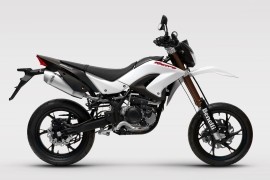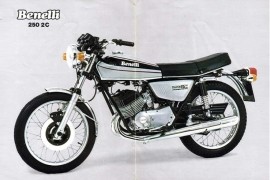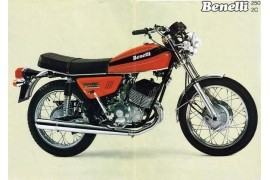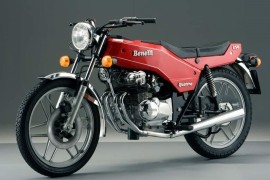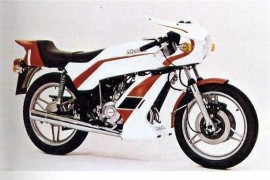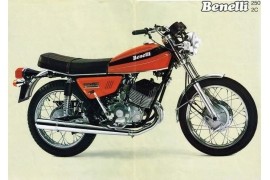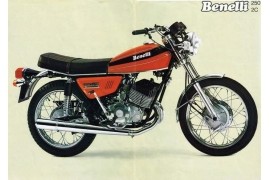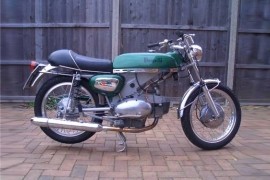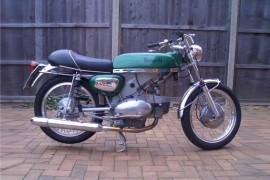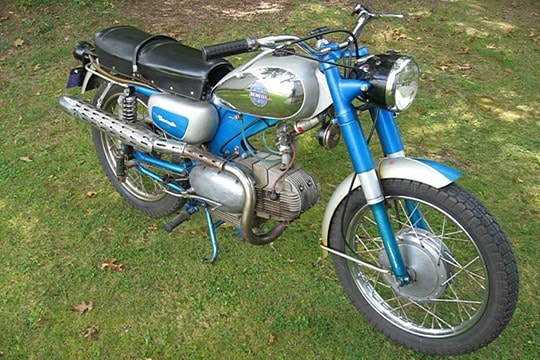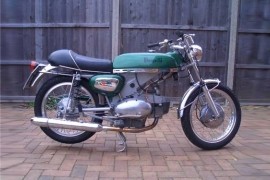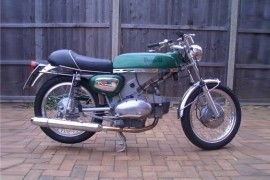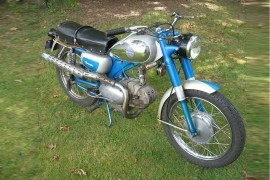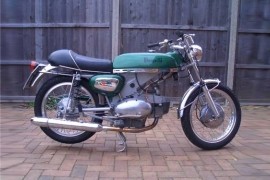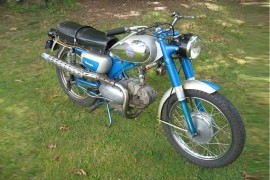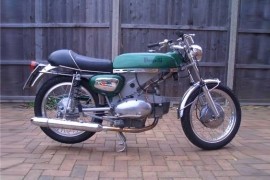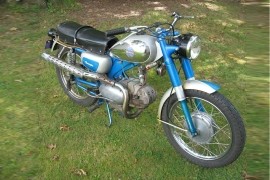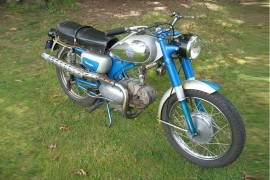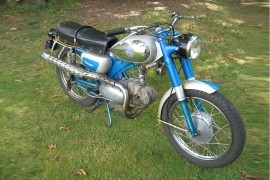BENELLI 250 Models/Series Timeline, Specifications & Photos
First production year: 1965
The 2012 MY Benelli 250 Motard sports a liquid-cooled, four-stroke, 249cc, single cylinder powerplant mated to a six-speed manual transmission, and can produce a claimed 25 horsepower and 21 Nm of torque. This mid-class supermotard also boasts standard features such as a 50mm telescopic front fork, an adjustable mono-shock in the rear with a progressive link, front and rear disc brakes, aluminium-alloy wheels, a minimal livery and an under-seat exhaust system.
The 1976 MY Benelli 250 2C is a classic, naked, Italian-built machine, suitable for riders of all categories. It sports an air-cooled, two-stroke, 231cc, parallel twin cylinder powerhouse mated to a five-speed manual transmission, and can reach a maximum power output of 30 horsepower at 6800 rpm.
In addition, it comes standard with a telescopic front fork, dual adjustable shocks as a rear suspension, a front disc brake coupled to a rear drum, a dual seat, laced wheels, a chromed, dual exhaust, wide handlebars, a chromed headlight, and an analogue instrument cluster.
In 1975, the Italian motorcycle maker released the Benelli 250 2C Phantom, a middle-class motorcycle in its second production year, featuring the same specifications as the previous one without any modifications whatsoever.
The Benelli 250 2C Phantom was a middle-class quarter-liter motorcycle manufactured by Benelli from 1974 until 1976 when it was dropped from production. The bike followed the popular layout of the quarter-liter class Japanese motorcycles.
The 1975 Benelli 250 2C Phantom was powered by a 231cc two-stroke air-cooled twin-cylinder engine that delivered an output power of 25 hp with a peak at 6,800 rpm and 24 Nm (18 lb-ft) torque at 6,400 rpm.
The bike's power was handled by a five-speed manual transmission that sent it to the rear end via a final chain drive, pushing the motorcycle to a top speed of 145 kph (90 mph).
The bike was made around a double-cradle steel frame that housed the suspension system comprised of a telescopic fork on the front and a swingarm with two adjustable side-mounted shock absorbers on the rear, offering optimum suspension performance and handling.
The bike's visual department was represented by features such as a round headlight with a chromed housing, analog instruments, a one-piece dual seat, side-mounted rear shocks, a dual exhaust system with a muffler mounted on each side, and wire-spoke wheels.
In 1975, the Italian motorcycle manufacturer introduced the Benelli 250 Quattro, a lightweight, performance-oriented machine that, as its name suggests, was powered by a quarter-liter four-cylinder engine.
The Italian designer tried their best to make the bike as modern as possible by fitting it with a tank/seat/rear fairing and an instrument nacelle with a hard-to-see tachometer and speedometer.
The bike's visual department was characterized by standard features, like six double-spoke aluminum alloy wheels, side-mounted rear shocks, a four-into-two exhaust system with a silencer on each side, a one-piece, two-up seat, and a round headlight upfront.
The 1975 Benelli 250 Quattro had its heartbeat set by a 231cc four-stroke air-cooled four-cylinder powerhouse fed by two Dell'Orto carburetors, delivering an output power of 26 hp with maximum strength at 10,500 rpm.
The bike was set in motion by a five-speed transmission that sent the power produced by the engine to the rear by a final chain drive, launching the motorcycle to 145 kph (90 mph).
The bike was built around a steel frame with a hydraulic telescopic fork on the front and a double-sided swingarm with two side-mounted shock absorbers on the rear, providing optimum suspension performance and handling capabilities.
The bike's wheels were fitted with a 260 mm brake disc on the front clamped to a cable-operated caliper and a 156 mm drum braking unit on the rear, providing optimum stopping performance.
In 1975, the Italian motorcycle maker introduced the Benelli 250 Cafe Racer, a quarter-liter middle-class motorcycle created for the more nostalgic riders among Benelli fans who still wanted improved performance.
The bike's aesthetic department was characterized by standard features, like a round headlight integrated into a cowl with a windscreen, a front engine fairing, a dual exhaust system with a muffler on each side, a one-piece dual seat, and three double-spoke aluminum alloy wheels.
The motorcycle was assembled around a double-cradle tubular steel frame, coupled to a telescopic fork on the front and a dual-sided swingarm with two adjustable side-mounted shocks on the rear, providing optimum handling capabilities.
As for the braking power, the motorcycle's wheels were fitted with two 260 mm brake discs clamped to cable-operated calipers on the front and a single 156 mm drum braking unit on the rear, offering optimum braking performance.
In the performance department, the 1975 Benelli 250 Cafe Racer had installed a 231cc two-stroke parallel-twin air-cooled engine underneath its fuel tank, delivering an output power of 30 hp with a peak force at 6,800 rpm.
The bike's engine was married to a five-speed transmission controlled by a wet multi-disc clutch that sent the power to the rear via a final chain drive, launching the motorcycle to a top speed of 145 kph (90 mph).
The Benelli 250 2C Phantom was a middle-class quarter-liter motorcycle manufactured by Benelli from 1974 until 1976 when it was dropped from production. The bike followed the popular layout of the quarter-liter class Japanese motorcycles.
In 1974, the Italian motorcycle maker introduced the Benelli 250 2C Phantom, a motorcycle with a twin sister made in the same factory but with Moto Guzi badges. The bike suited riders of all ages and experience levels.
In the visual department, the bike packed a round headlight with a chromed housing, analog instruments, a one-piece dual seat, side-mounted rear shocks, a dual exhaust system with a muffler mounted on each side, and wire-spoke wheels.
The bike was built around a double-cradle steel frame that housed the suspension system comprised of a telescopic fork on the front and a swingarm with two adjustable side-mounted shock absorbers on the rear, offering optimum suspension performance and handling.
As for the braking power, the motorcycle's 18-inch wheels were fitted with a single 180 mm drum braking unit on the front and a 158 mm drum braking unit on the rear, providing optimum braking performance.
In the performance department, the 1974 Benelli 250 2C Phantom was powered by a 231cc two-stroke air-cooled twin-cylinder engine that delivered an output power of 25 hp with a peak at 6,800 rpm and 24 Nm (18 lb-ft) torque at 6,400 rpm.
The Benelli 250 2C Phantom was a middle-class quarter-liter motorcycle produced by Benelli from 1974 until 1976, when it was dropped from production. The bike followed the popular layout of the quarter-liter class Japanese motorcycles.
In 1976, the Italian motorcycle manufacturer released the Benelli 250 2C Phantom, a quarter-liter motorcycle in its last production year. It was built for only three years and remained unchanged with no modifications whatsoever.
The bike was produced around a double-cradle steel frame that housed the suspension system comprised of a telescopic fork on the front and a swingarm with two adjustable side-mounted shock absorbers on the rear, offering optimum suspension performance and handling.
As for the stopping power, the motorcycle packed a single 180 mm drum braking unit on the front and a 158 mm drum braking unit on the rear, providing optimum braking performance.
The visual department was characterized by fittings like a round headlight with a chromed housing, analog instruments, a one-piece dual seat, side-mounted rear shocks, a dual exhaust system with a muffler mounted on each side, and wire-spoke wheels.
As for power, the 1976 Benelli 250 2C Phantom had its heartbeat set by a 231cc two-stroke air-cooled twin-cylinder engine mounted underneath the fuel tank, boasting 25 hp with a peak at 6,800 rpm and 24 Nm (18 lb-ft) torque at 6,400 rpm.
In 1972, the Italian motorcycle maker released the Benelli 250 Sport Special, a quarter-liter motorcycle in its fifth consecutive production year that packed the same specifications as the previous one without any changes.
The 1972 model came in the same shape and form as the previous one, which was revised, featuring a Marzocchi front fork and a higher, adjustable handlebar. The model survived until 1973, before it was discontinued.
The 1972 Benelli 250 Sport Special was set in motion by a 245cc four-stroke air-cooled single-cylinder engine mounted underneath its fuel tank, delivering 12 hp with maximum strength at 8,500 rpm.
The power crafted by the quarter-liter engine was converted into speed by a five-speed manual transmission controlled by a wet multi-plate clutch and sent to the rear axle via a final chain drive, launching the motorcycle to 140 kph (87 mph).
The bike was built around an open-cradle tubular steel frame with a Marzocchi telescopic fork on the front and a swingarm with side-mounted hydraulic shock absorbers on the rear, offering optimum handling capabilities.
As for the stopping power, the bike packed a 175 mm drum braking unit on the front and a 125 mm drum braking unit on the rear, offering the braking performance needed to stop the bike in safe conditions.
Aesthetically, the motorcycle packed features like a round headlight with a chromed housing, analog instruments, a long fuel tank, a one-piece, two-up seat, side-mounted rear shocks, a single exhaust system with a silencer mounted on the right-hand side, a center stand, and cross-spoke wheels.
The Benelli 250 Sport Special was a quarter-liter middle-weight machine produced by Benelli in 1968 alongside the smaller 125cc version. The bike was produced until 1973 and remained unchanged over its production time.
In 1971, the Italian motorcycle manufacturer released the Benelli 250 Sport Special, a motorcycle in its fourth consecutive production year. The 1971 model was revised, featuring a Marzocchi front fork and a higher, adjustable handlebar. The model survived only for two more years before it was discontinued.
In the visual department, the motorcycle packed a round headlight with a chromed housing, analog instruments, a long fuel tank, a one-piece, two-up seat, side-mounted rear shocks, a single exhaust system with a silencer mounted on the right-hand side, a center stand, and cross-spoke wheels.
The bike's riding characteristics were offered by an open-cradle tubular steel frame with a Marzocchi telescopic fork on the front and a swingarm with side-mounted hydraulic shock absorbers on the rear, offering optimum handling capabilities.
In the braking department, the motorcycle packed a 175 mm drum braking unit on the front and a 125 mm drum braking unit on the rear, offering the braking performance needed to stop the bike in safe conditions.
As for the power figures, the 1971 Benelli 250 Sport Special had its heartbeat set by a 245cc four-stroke air-cooled single-cylinder engine mounted underneath its fuel tank, delivering 12 hp with maximum strength at 8,500 rpm.
In 1970, the Italian motorcycle maker introduced the Benelli 250 Barracuda, a bike in its last production year. It was fitted with features like a round headlight upfront, analog instruments, a long fuel tank, a one-piece dual seat, a single exhaust system with a silencer mounted on the right-hand side, a center stand, and wire-spoke wheels shod with road tires.
The Benelli 250 Barracuda was a quarter-liter, classic, middleweight motorcycle suitable for all categories of riders. The bike was produced from 1965 to 1970 and remained unchanged over its production time.
In the performance department, the 1970 Benelli 250 Barracuda had its soul brought to life by a 245cc four-stroke single-cylinder air-cooled engine, managed by a 24 mm Dell'Orto carburetor, delivering 24 hp with a peak force at 8,200 rpm.
The power generated by the engine was transferred to a five-speed manual transmission and then to the rear wheel through a final chain drive.
The bike was built around an open-cradle tubular steel frame coupled to a double-action hydraulic telescopic fork on the front with a steering damper and side-mounted shock absorbers on the rear, offering optimum handling capabilities.
In the braking department, the bike packed a 176 mm single leading shoe drum unit on the front and a 158 mm trailing shoe drum unit on the rear, providing optimum stopping performance.
The Benelli 250 Sport Special was a quarter-liter middle-weight machine launched by Benelli in 1968 alongside the smaller 125cc version. The bike was produced until 1973 and remained unchanged over its production time.
In 1970, the Italian motorcycle maker released the Benelli 250 Sport Special, an entry-level machine in its second production year. The bike was designed for all types of riders with different ages and experience levels.
The 1970 motorcycle came in the same shape and form as the previous ones, featuring the same technical, visual, and performance specifications without any significant changes whatsoever.
Aesthetically, the motorcycle was characterized by features such as a round headlight with a chromed housing, analog instruments, a long fuel tank, a one-piece, two-up seat, side-mounted rear shocks, a single exhaust system with a silencer mounted on the right-hand side, a center stand, and cross-spoke wheels.
In the performance department, the 1970 Benelli 250 Sport Special had installed a 245cc four-stroke air-cooled single-cylinder engine underneath its fuel tank, boasting 12 hp with maximum strength at 8,500 rpm.
The power generated by the quarter-liter engine was converted into speed by a five-speed manual transmission controlled by a wet multi-plate clutch and sent to the rear axle via a final chain drive, launching the motorcycle to 140 kph (87 mph).
In 1969, the Italian motorcycle maker released the Benelli 250 Sport Special, an entry-level motorcycle in its second production year. The bike was designed for all types of riders with different ages and experience levels.
The Benelli 250 Sport Special was a quarter-liter middle-weight machine launched by Benelli in 1968 alongside the smaller 125cc version. The bike was produced until 1973 and remained unchanged over its production time.
In the performance department, the 1969 Benelli 250 Sport Special had its soul brought to life by a 245cc four-stroke air-cooled single-cylinder engine placed underneath its fuel tank, boasting 12 hp with maximum strength at 8,500 rpm.
The power produced by the small engine was converted into motion by a five-speed manual transmission controlled by a wet multi-plate clutch and sent to the rear end via a final chain drive, launching the motorcycle to 140 kph (87 mph).
The bike's riding characteristics were provided by an open-cradle tubular steel frame with a telescopic fork on the front and a swingarm with side-mounted hydraulic shock absorbers on the rear, offering optimum handling capabilities.
As for the braking performance, the bike's 18-inch wheels were equipped with a 175 mm drum braking unit on the front and a 125 mm drum braking unit on the rear, offering the braking performance needed to stop the bike in safe conditions.
In 1969, the Italian motorcycle maker released the Benelli 250 Barracuda, a quarter-liter motorcycle, in its fifth consecutive production year. The bike was created for riders of all ages and experience levels.
The Benelli 250 Barracuda was a quarter-liter, classic, middleweight motorcycle suitable for all categories of riders. The bike was produced from 1965 to 1970 and remained unchanged over its production time.
In the visual department, the motorcycle packed features such as a round headlight upfront, analog instruments, a long fuel tank, a one-piece dual seat, a single exhaust system with a silencer mounted on the right-hand side, a center stand, and wire-spoke wheels shod with road tires.
The bike was built around an open-cradle tubular steel frame coupled to a double-action hydraulic telescopic fork on the front with a steering damper and side-mounted shock absorbers on the rear, offering optimum handling capabilities.
As for the braking power, the bike relied on a 176 mm single leading shoe drum unit on the front and a 158 mm single trailing shoe drum unit on the rear, providing optimum stopping performance.
In the power department, the 1969 Benelli 250 Barracuda had its heartbeat set by a 245cc four-stroke single-cylinder air-cooled engine, managed by a 24 mm Dell'Orto carburetor, delivering 24 hp with a peak force at 8,200 rpm.
The Benelli 250 Sport Special was a quarter-liter middle-weight motorcycle introduced by Benelli in 1968 alongside the smaller 125cc version. The bike was manufactured until 1973 and remained unchanged over its production time.
In 1968, the Italian motorcycle manufacturer introduced the Benelli 250 Sport Special, a larger displacement version of the Benelli 125 Sport Special. It was created for riders of all ages and experience levels.
The bike's aesthetic department was characterized by elements such as a round headlight with a chromed housing, analog instruments, a long fuel tank, a one-piece, two-up seat, side-mounted rear shocks, a single exhaust system with a silencer mounted on the right-hand side, a center stand, and cross-spoke wheels.
The bike was made around an open-cradle tubular steel frame with a telescopic fork on the front and a swingarm with side-mounted hydraulic shock absorbers on the rear, offering optimum handling capabilities.
Regarding stopping power, the motorcycle's 18-inch spoke wheels were fitted with a 175 mm drum braking unit on the front and a 125 mm drum braking unit on the rear, providing the braking performance needed to stop the bike in safe conditions.
As for power, the 1968 Benelli 250 Sport Special had installed a 245cc four-stroke air-cooled single-cylinder engine underneath its fuel tank, delivering an output power of 12 hp with maximum strength at 8,500 rpm.
The Benelli 250 Barracuda was a quarter-liter, classic, middleweight motorcycle suitable for all categories of riders. The bike was manufactured from 1965 to 1970 and remained largely unchanged over its production period.
In 1968, the Italian bike maker released the Benelli 250 Barracuda, a motorcycle in its fourth consecutive production year that packed the same characteristics as previous ones without any changes whatsoever.
At the bike's core was a 245cc four-stroke single-cylinder air-cooled engine, fed by a 24 mm Dell'Orto carburetor, boasting 24 hp with a peak force at 8,200 rpm. The rear wheel was spun by a final chain drive linked to a five-speed manual transmission that took the engine's energy, transforming it into motion.
The bike was built around an open-cradle tubular steel frame that housed the suspension system comprised of a double-action hydraulic telescopic fork on the front with a steering damper and side-mounted shocks on the rear, providing optimum handling capabilities.
The bike's 18-inch wire-spoke wheels were fitted with a 176 mm leading shoe drum unit on the front wheel and a 158 mm trailing shoe drum unit on the rear, offering optimum braking performance.
As for appearance, the 1968 Benelli 250 Barracuda packed a round headlight upfront, analog instruments, a long fuel tank, a one-piece dual seat, a single exhaust system with a silencer mounted on the right-hand side, a center stand, and wire-spoke wheels shod with road tires.
The Benelli 250 Sport Special was a quarter-liter middle-weight machine launched by Benelli in 1968 alongside the smaller 125cc version. The bike was produced until 1973 and remained unchanged over its production time.
In 1973, the Italian motorcycle maker released the Benelli 250 Sport Special, a motorcycle that debuted in 1968 and was manufactured until 1973, when it was dropped from production. Over its production period, the bike was revised only once in 1971, receiving a Marzocchi front fork and a higher, adjustable handlebar.
The 1973 motorcycle came in the same shape and form as the previous two models, packing the same technical, visual, and performance specifications without any significant modifications whatsoever.
The bike's visual department was characterized by features like a round headlight with a chromed housing, analog instruments, a long fuel tank, a one-piece, two-up seat, side-mounted rear shocks, a single exhaust system with a silencer mounted on the right-hand side, a center stand, and cross-spoke wheels.
In the performance department, the 1973 Benelli 250 Sport Special had its heartbeat set by a 245cc four-stroke air-cooled single-cylinder engine mounted underneath its fuel tank, delivering 12 hp with maximum strength at 8,500 rpm.
The power produced by the powerhouse was handled by a five-speed transmission that sent it to the rear end via a final chain drive, pushing the motorcycle to a top speed of 140 kph (87 mph).
The Benelli 250 Barracuda was a middle-weight, quarter-liter class, Italian-built motorcycle introduced in 1965. The bike was created to suit riders of all ages and experience levels and ended production in 1970.
In 1967, the Italian motorcycle maker released the Benelli 250 Barracuda, a motorcycle in its third consecutive production year. Until it was dropped in 1970, the bike kept its features in the same state, without changes.
The 1967 machine came equipped with the same package as previous ones, boasting the same performance, visual, and technical characteristics without any significant modifications whatsoever.
Visually, the bike was characterized by features like a round headlight upfront, analog instruments, a long fuel tank, a one-piece dual seat, a single exhaust system with a silencer mounted on the right-hand side, a center stand, and wire-spoke wheels shod with road tires.
In the performance department, the 1967 Benelli 250 Barracuda had installed a 245cc four-stroke single-cylinder air-cooled engine, managed by a 24 mm Dell'Orto carburetor, delivering 24 hp with maximum strength at 8,200 rpm.
The power generated by the quarter-liter engine was handled by a five-speed manual transmission and delivered to the rear wheel by a final chain drive.
In addition, the bike's riding characteristics were provided by an open-cradle tubular steel frame tied to a double-action hydraulic telescopic fork on the front with a steering damper and side-mounted shocks on the rear.
In 1966, the Italian motorcycle manufacturer released the Benelli 250 Barracuda, a motorcycle in its second production year. It was a quarter-liter machine created for a wide variety of riders.
The 1966 model came in the same shape and form as the previous one, delivering the same visual, technical, and performance characteristics without any modifications whatsoever.
The Benelli 250 Barracuda was a quarter-liter, classic, middleweight machine suitable for all categories of riders. The bike was manufactured from 1965 to 1970 and remained largely unchanged over its production period.
Suspension-wise, the bike packed a double-action hydraulic telescopic fork on the front with a steering damper and side-mounted shocks on the rear, all mounted on an open-cradle tubular steel frame, offering optimum handling capabilities.
The braking power was achieved by a single 176 mm leading shoe drum unit mounted on the front wheel and a single 158 mm trailing shoe drum unit mounted on the rear, offering optimum stopping performance.
The 1966 Benelli 250 Barracuda was powered by a 245cc four-stroke single-cylinder air-cooled engine fed by a 24 mm Dell'Orto carburetor, delivering 24 hp with a peak force at 8,200 rpm.
As for its visual department, the bike had features such as a round headlight upfront, analog instruments, a long fuel tank, a one-piece dual seat, a single exhaust system with a silencer mounted on the right-hand side, a center stand, and wire-spoke wheels shod with road tires.
The Benelli 250 Barracuda was a quarter-liter, classic, middleweight machine suitable for all categories of riders. The bike was manufactured from 1965 to 1970 and remained largely unchanged over its production period.
In 1965, the Italian motorcycle manufacturer launched the Benelli 250 Barracuda, a motorcycle fitted with features such as a round headlight upfront, analog instruments, a long fuel tank, a one-piece dual seat, a single exhaust system with a silencer mounted on the right-hand side, a center stand, and wire-spoke wheels shod with road tires.
The bike was built around an open-cradle tubular steel frame coupled to a double-action hydraulic telescopic fork on the front with a steering damper and side-mounted shocks on the rear, providing optimum handling capabilities.
As for the braking power, the bike packed a 176 mm single leading shoe drum unit on the front and a 158 mm single trailing shoe drum unit on the rear, providing optimum stopping performance.
As for the power figures, the 1965 Benelli 250 Barracuda had its heartbeat set by a 245cc four-stroke single-cylinder air-cooled engine, fed by a 24 mm Dell'Orto carburetor, boasting 24 hp with a peak force at 8,200 rpm.
The rear wheel was spun by a final chain drive linked to a five-speed manual transmission that took the engine's energy, transforming it into motion.
